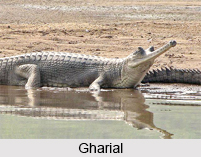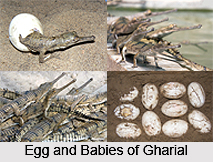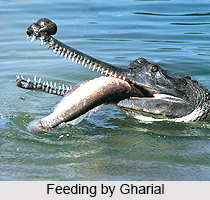 Gharial is an Indian reptile that bears a scientific name "Gavialis gangeticus" and belongs to the family of Gavialidae.
Gharial is an Indian reptile that bears a scientific name "Gavialis gangeticus" and belongs to the family of Gavialidae.
Category of Gharial
Gharial is also known as the gavial, and the fish-eating crocodile, is a crocodilian of the family of Gavialidae, native to the northern part of the Indian states like Odisha, Indian Tidal or Mangrove Forests of West Bengal, Bihar, Andhra Pradesh.
Population of Gharial
The global population is estimated at fewer than 235 individuals, which are threatened by loss of riverine habitat, depletion of fish resources, and entanglement in fishing nets. As the population has declined drastically in the past 70 years, the gharial is listed as Critically Endangered on the IUCN Red List.
Structure of Gharial
Gharial is one of the longest of all living crocodilians, measuring up to 6.25 m (20.5 ft), though it should be noted that this is an extreme upper limit, as the average adult gharial is only 3.5 to 4.5 m (11 to 15 ft) in size. With 110 sharp, interdigitated teeth in its long, thin snout, it is well adapted to catching fish, its main diet. The male gharial has a distinctive boss at the end of the snout, which resembles an earthenware pot known in Hindi as ghara. The gharial`s common name is derived from this similarity.
Habitat of Gharial
Gharial was once inhabited in all the major river systems of the Indian States, from the Irrawaddy River in the east to the Indus River in the west. Their distribution is now limited to only 2% of their former range. They inhabit foremost flowing rivers with high sand banks that they use for basking and building nests. They usually mate in the cold season. The young hatch before the onset of the monsoon.
Jaws of Gharial
The gharial is characterised by its extremely long, thin jaws, which are regarded as an adaptation to a primarily piscivorous diet. Males reach up to 6 m (20 ft) with an average weight of around 160 kg (350 lb).
Body of Gharial
Gharial is dark or light olive above with dark cross-bands and speckling on the head, body and tail. Dorsal surfaces become dark, almost grey-black, at about 20 years of age. Ventral surfaces are yellowish-white. The neck is elongated and thick. The dorsal ridges are more or less restricted to the median regions of the back. The fingers are extremely short and thickly webbed. Males develop a hollow bulbous nasal protuberance at the tip of the snout upon sexual maturity. Gharials are the only extant crocodilian with visible sexual dimorphism. Although the function of the nasal boss is not well understood, it is apparently used as a visual sex indicator, as a sound resonator, or for bubbling or other associated sexual behaviours.
Size of Gharial
The average size of gharial is 3.5 to 4.5 m (11 to 15 ft). The largest recorded length is 6.25 m (20.5 ft), and the largest recorded weight is 977 kg (2,154 lb). Hatchlings approximate 37 cm (15 in). Young gharials can reach a length of 1 m (3.3 ft) in 18 months. The average body weight ranges from 159 to 250 kg (351 to 551 lb). Males commonly attain a total length of 3 to 5 m (9.8 to 16.4 ft), while females are smaller and reach a body length of up to 2.7 to 3.75 m (8.9 to 12.3 ft).
Feeding by Gharial
Gharials do not kill and eat humans. Jewellery found in their stomachs may have been the reason for the myth that gharials are man-eaters. They may have swallowed this jewellery as gastroliths used to aid digestion or buoyancy management.











